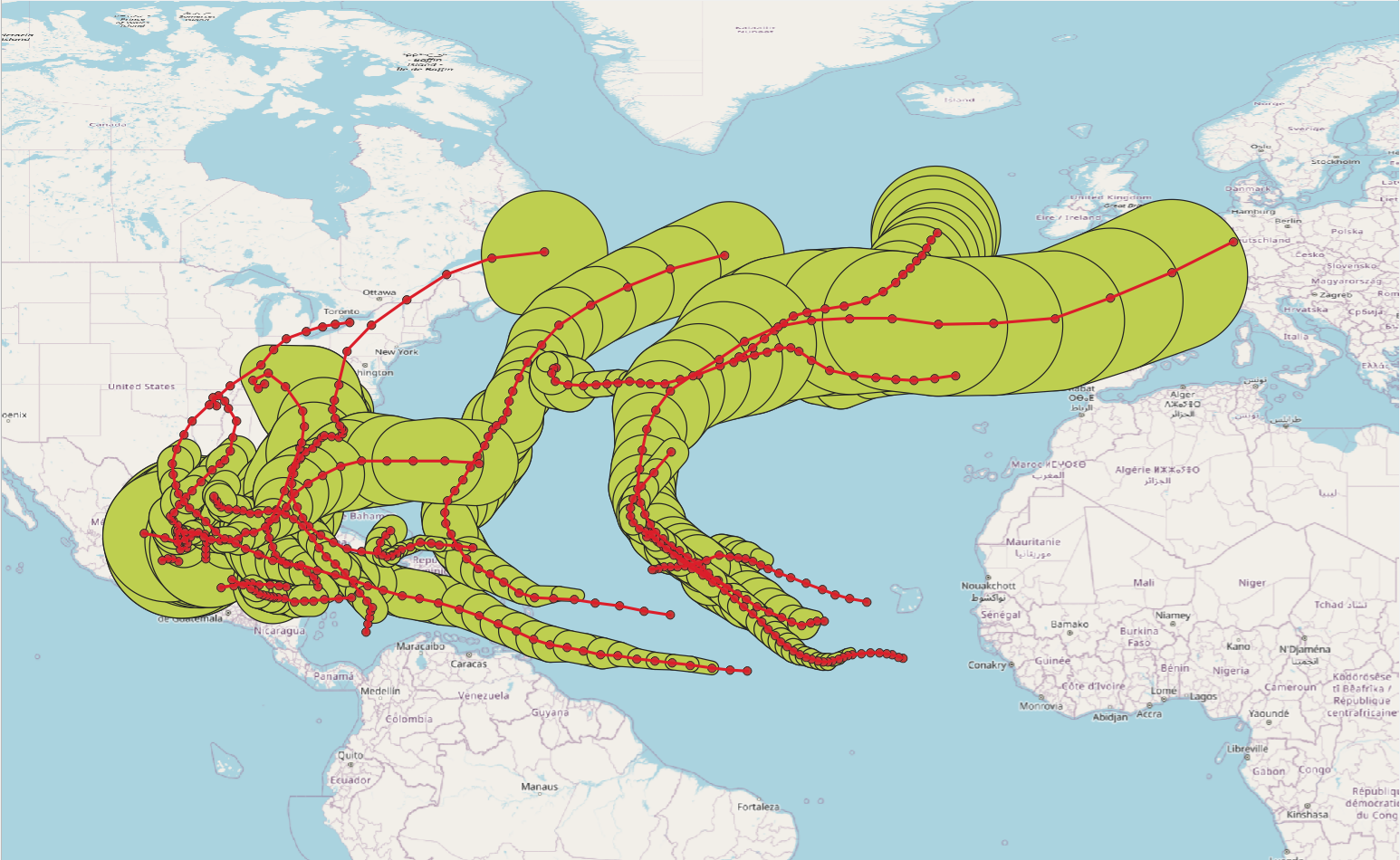Table of Contents
A static circular buffer type cbuffer represents a 2D point and a radius greater than or equal to 0 around the point. The radius represent the “impact” of the point on its surroundings. This impact could be interpreted as noise, pollution, or similar aspects depending on application requirements.
The cbuffer type serves as base type for defining the temporal circular buffer type tcbuffer. The tcbuffer type has similar functionality as the temporal point type tgeompoint with the exception that it only considers two dimensions. Thus, most functions and operators described before for the tgeompoint type are also applicable for the tcbuffer type. In addition, there are specific functions defined for the tcbuffer type.
Figure 13.1, “Illustration of the use of the tcbuffer type for modelling the circular buffer around the wind swath of tropical storms in 2024.” illustrates the use of the tcbuffer type for modelling the circular buffer around the wind swath of tropical storms in 2024. The data is obtained from the National Oceanic and Atmospherique Administration (NOAA). As illustrated in the figure, the types tgeompoint and tcbuffer allow linear interpolation, while as we have seen in Figure 7.2, “Illustration of the use of the tgeompoint (top) and the tgeometry (bottom) types for modelling the trajectory and the wind swath of tropical storms in 2024.”, the type tgeometry only allows step interpolation.
Figure 13.1. Illustration of the use of the tcbuffer type for modelling the circular buffer around the wind swath of tropical storms in 2024.

A cbuffer value is a couple of the form (point,radius) where point is a geometric point and radius is a float value greater than or equal to zero representing a radius around the point expressed using the units of the SRID of the point. Examples of input of circular buffer values are as follows:
SELECT cbuffer 'Cbuffer(Point(1 1), 0.3)'; SELECT cbuffer 'Cbuffer(Point(1 1), 10.0)';
The cbuffer type corresponds to the result of the PostGIS function ST_MinimumBoundingRadius.
Values of the circular buffer type must satisfy several constraints so that they are well defined. Examples of incorrect circular buffer type values are as follows.
-- incorrect point value SELECT cbuffer 'Cbuffer(Linestring(1 1,2 2), 1.0)'; -- incorrect 3D point SELECT cbuffer 'Cbuffer(Point Z(1 1 1), 1.0)'; -- incorrect radius value SELECT cbuffer 'Cbuffer(Point(1 1), -2.0)';
We give next the functions and operators for the circular buffer type.
Values of the cbuffer type can be converted to the geometry type using an explicit CAST or using the :: notation as shown below. Similarly, a geometry can be converted to a cbuffer value using the ST_MinimumBoundingRadius function in PostGIS.
Convert between a circular buffer and a geometry
geometry::cbuffercbuffer::geometrySELECT ST_AsText(cbuffer(ST_Point(1,1), 1)::geometry); -- CURVEPOLYGON(CIRCULARSTRING(0 1,2 1,0 1)) SELECT asText(geometry 'SRID=5676;CIRCULARSTRING(0 1,2 1,0 1)'::cbuffer); -- Cbuffer(POINT(1 1),1) SELECT asText(geometry 'SRID=5676;LINESTRING(0 0,2 2)'::cbuffer); -- Cbuffer(POINT(1 1),1.414213562373095)
Convert a circular buffer and, optionally, a timestamp or a period, to a spatiotemporal box
stbox(cbuffer) → stboxstbox(cbuffer,{timestamptz,tstzspan}) → stboxSELECT stbox(cbuffer 'SRID=5676;Cbuffer(Point(1 1),0.3)'); -- SRID=5676;STBOX X((0.7,0.7),(1.3,1.3)) SELECT stbox(cbuffer 'Cbuffer(Point(1 1),0.3)', timestamptz '2001-01-01'); -- STBOX XT(((0.7,0.7),(1.3,1.3)),[2001-01-01, 2001-01-01]) SELECT stbox(cbuffer 'Cbuffer(Point(1 1),0.3)', tstzspan '[2001-01-01,2001-01-02]'); -- STBOX XT(((0.7,0.7),(1.3,1.3)),[2001-01-01, 2001-01-02])
Return or set the spatial reference identifier
SRID(cbuffer) → integersetSRID(cbuffer) → cbufferSELECT SRID(cbuffer 'Cbuffer(SRID=5676;Point(1 1), 0.3)'); -- 5676 SELECT asEWKT(setSRID(cbuffer 'Cbuffer(Point(0 0),1)', 4326)); -- SRID=4326;Cbuffer(POINT(0 0),1)
Transform to a spatial reference identifier
transform(cbuffer,integer) → cbuffertransformPipeline(cbuffer,pipeline text,to_srid integer,is_forward bool=true) →cbufferThe
transformfunction specifies the transformation with a target SRID. An error is raised when the input circular buffer has an unknown SRID (represented by 0).The
transformPipelinefunction specifies the transformation with a defined coordinate transformation pipeline represented with the following string format:urn:ogc:def:coordinateOperation:AUTHORITY::CODEThe SRID of the input circular buffer is ignored, and the SRID of the output circular buffer will be set to zero unless a value is provided via the optional
to_sridparameter. As stated by the last parameter, the pipeline is executed by default in a forward direction; by setting the parameter to false, the pipeline is executed in the inverse direction.SELECT asEWKT(transform(cbuffer 'SRID=4326;Cbuffer(Point(4.35 50.85),1)', 3812)); -- SRID=3812;Cbuffer(POINT(648679.0180353033 671067.0556381135),1)
WITH test(cbuffer, pipeline) AS ( SELECT cbuffer 'Cbuffer(SRID=4326;Point(4.3525 50.846667),1)', text 'urn:ogc:def:coordinateOperation:EPSG::16031' ) SELECT asEWKT(transformPipeline(transformPipeline(cbuffer, pipeline, 4326), pipeline, 4326, false), 6) FROM test; -- SRID=4326;Cbuffer(POINT(4.3525 50.846667),1)
The comparison operators (=, <, and so on) are available for circular buffers. They compare first the points and then the radius of the arguments. Excepted the equality and inequality, the other comparison operators are not useful in the real world but allow B-tree indexes to be constructed on circular buffers.
Traditional comparisons
cbuffer {=, <>, <, >, <=, >=} cbufferSELECT cbuffer 'Cbuffer(Point(3 3), 0.5)' = cbuffer 'Cbuffer(Point(3 3), 0.5)'; -- true SELECT cbuffer 'Cbuffer(Point(3 3), 0.5)' <> cbuffer 'Cbuffer(Point(3 3), 0.6)'; -- true SELECT cbuffer 'Cbuffer(Point(3 3), 0.5)' < cbuffer 'Cbuffer(Point(3 3), 0.6)'; -- true SELECT cbuffer 'Cbuffer(Point(3 3), 0.6)' > cbuffer 'Cbuffer(Point(2 2), 0.6)'; -- true SELECT cbuffer 'Cbuffer(Point(1 1), 0.5)' <= cbuffer 'Cbuffer(Point(2 2), 0.5)'; -- true SELECT cbuffer 'Cbuffer(Point(1 1), 0.6)' >= cbuffer 'Cbuffer(Point(1 1), 0.5)'; -- true